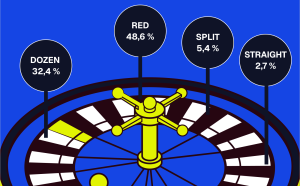Table of content
Many people like the D’Alembert approach because it’s easy to understand. It’s similar to the Martingale system and encourages players to bet more after losing a roulette round. Some people even call it the father of all betting systems. Let’s learn more about why this strategy is so sought-after.
The History of Strategy
The D’Alembert system is a betting method used in gambling games for many years. A famous French mathematician, physicist, and philosopher named Jean-Baptiste le Rond d’Alembert created it. He was interested in many scientific subjects, including gambling and game theory. D’Alembert’s betting strategy aims to make the most profit while losing the least money. The idea is to balance wins and losses to make a net profit. Players commonly use the strategy in games with even or near-even odds, like baccarat and roulette.
The Principle of Operation of the Strategy
The basic principle is to raise your bet by one unit after a loss and lower it by one unit after a win. This strategy aims to profit from winning streaks while limiting losses during losing ones.
Players have changed the D’Alembert system over time to deal with problems. The inverse D’alembert system, often called the Contra D’alembert system or the Anti-Martingale system, is one version. In this variant, participants raise their bets after a win and lower them after a loss.
The Mathematics of This System
The player uses the D’alembert technique to bet on events with odds of 2 to 4. They should only use up to 3% of their bank for the first bet, usually one unit. The goal is to make a profit equal to the first bet. Here is the betting algorithm:
Pick a bet with odds from 2 to 4.
Set the bet to one and distribute between 1 and 3 percent of the game pot.
If the bet succeeds, the next bet increases by one unit (1 unit if the bet was successful).
The second bet is raised by one if the previous one fails.
Start a new cycle if you can make 5-10% of your bets.
The player has a wide choice of events due to the circumstances of the odds. He can bet on various sports and positions. These are not guaranteed results; you can also use totals, handicaps, period bets, and individual player performance bets.
Success Story
Don Johnson is a famous gambler who used the D’alembert System to win $6 million at the Borgata Casino & Spa in Atlantic City in 2011. He started with a small bet of $5 and gradually increased it as he won. Don believes that discipline is essential for successful gambling. Without self-control, a player may make bad decisions and lose money.
To cap it all, the system raises bets after losing and lowers them after winning to minimize losses and increase profits. Before using this strategy, it’s pivotal for players to learn how professionals use it and understand how it works.
Page Information
Topics
StrategiesRelated

Players often ask this question to determine whether participating in a certain game might break any laws, regulations, or fundamental principles. In this article, we’ll explore what gambling actually means and why understanding it is so important.

Roulette is simple, fun, and timeless. This guide covers the rules, wheel types, payouts, and strategies you need to play smarter and enjoy every spin.

Knowing the odds in roulette helps you make informed bets and understand exactly what you’re risking with each spin.

Roulette offers a variety of bet types, each with its own risk level and payout, letting players choose between safer options and high-reward wagers.




